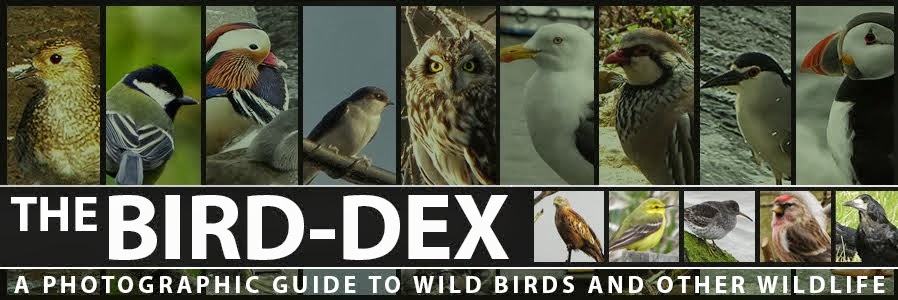OTHER NAMES: N/A
Latin Etymology: Apus ("swift") pallidus ("paler")
Three Pallid Swift (subspecies A. p. brehomorum) in Seville, Spain - November 2011
Featured Subspecies: Apus pallidus brehmorum
Weight: 38-45g / Length: 16-17cm / Wingspan: 42cm
NO UK STATUS / IUCN Red List: Least Concern
I will be first to admit that taken on it's own, this photo is entirely inadequate to be able to positively identify these birds - about the only feature that even particularly suggests them is the spread tail, which Pallid Swifts apparently do more than Common Swift, but that is hardly diagnostic in one photo. Essentially, this photo is really only suitable to identify these birds in when it was taken - November, long after Common Swifts have left Spain. I pondered for a good while about using this picture, but as swifts are by far the hardest common bird to photograph well, I decided that this would have to do for now. Generally speaking, the Pallid Swift is a slightly paler version of the Common with different features that would be apparent if you held them next to each other, but not really enough to correctly identify them in anything but the best circumstances when whizzing around at high speed. They are more common in Southern Spain but are present in lower numbers in cities like Madrid. while in the UK they are only a vagrant,
Related Species:
Order: Apodiformes
Family: Apodidae
Genus: Apus
Subspecies: A. p . pallidus, A. p. brehmorum, A. p. illyricus- Sighting Locations -
- SICILY 2018 TRIP - Seen from Syracuse
SPAIN - Spanish - Vencejo pálido ("Pale Swift")
- SEVILLE 2011 TRIP: Common around Seville in November 2011 (after Common Swift have left).
Common to locally abundant resident, particularly in Cities.
- MADRID 2015 TRIP: Possibly seen - large quantities of Common Swift may have contained Pallid.
- MADRID 2016 TRIP: Possibly seen - large quantities of Common Swift may have contained Pallid.
Further Notes: BirdForum Opus, IUCN Red List, RSPB, Wikipedia, Xeno-canto


No comments:
Post a Comment